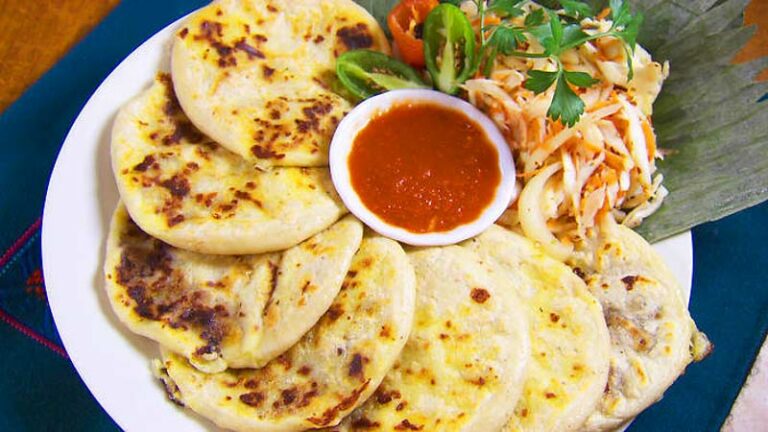Introduction: El Salvadoran Cuisine
El Salvadoran cuisine is a reflection of the country’s rich history and diverse cultural influences. Located in Central America, El Salvador is home to a variety of unique dishes that are renowned for their delicious flavors and colorful presentations. The cuisine of El Salvador is a blend of indigenous, Spanish, and African cultures, resulting in a unique fusion of flavors and ingredients.
Corn, Beans, and Pupusas
Corn and beans are the staples of El Salvadoran cuisine. Corn is used to make tortillas, tamales, and pupusas, which are a traditional Salvadoran dish made of a thick corn tortilla stuffed with beans, cheese, and meat. Pupusas are considered to be the national dish of El Salvador and are a popular street food throughout the country. They are often served with curtido, a pickled cabbage salad, and a spicy tomato sauce.
A Balance of Flavors
El Salvadoran cuisine is known for its balance of flavors, combining sweet, sour, and savory tastes in each dish. Basic ingredients such as onions, garlic, and tomatoes are used in many dishes to create a depth of flavor. Achiote, a spice made from annatto seeds, is also commonly used to add flavor and color to dishes. The cuisine also incorporates a variety of fruits, such as papaya, mango, and pineapple, to add sweetness to savory dishes.
Traditional Salvadoran Dishes
Aside from pupusas, El Salvadoran cuisine features a variety of traditional dishes that are unique to the country. One such dish is yuca con chicharron, which is fried yucca served with crispy pork. Another popular dish is sopa de res, a hearty beef soup with vegetables and rice. Tamales, which are made of corn dough and stuffed with meat, vegetables, or cheese, are also a popular food in El Salvador.
Seafood and Tropical Fruits
El Salvador’s location on the Pacific coast means that seafood is a popular ingredient in the country’s cuisine. Pargo rojo, or red snapper, is a common fish served in El Salvador, as well as camarones al ajillo, shrimp in garlic sauce. The country’s tropical climate also allows for an abundance of fresh fruits, such as papaya, mango, and guava, which are often used in desserts and drinks.
Common Spices and Herbs
El Salvadoran cuisine uses a variety of spices and herbs to add flavor to dishes. Cumin, coriander, and oregano are commonly used in meat dishes, and cilantro is used in many sauces and marinades. Cloves and cinnamon are often used in desserts, such as the traditional dessert called budin, a bread pudding made with sweetened condensed milk.
Influences from Neighboring Countries
El Salvador shares a culinary heritage with its neighbors, including Guatemala, Honduras, and Mexico. As a result, El Salvadoran cuisine has been influenced by the dishes of these countries. For example, tamales and tortillas are common to many Latin American countries, as are beans and rice. However, El Salvadoran cuisine has its own unique flavors and ingredients that set it apart from its neighbors.
Conclusion: A Taste of El Salvador
El Salvadoran cuisine is a unique and delicious blend of indigenous, Spanish, and African cultures. From the staple ingredients of corn and beans to the use of fresh tropical fruits and seafood, the cuisine of El Salvador offers a diverse and flavorful range of dishes. Whether you’re enjoying the national dish of pupusas or savoring a bowl of sopa de res, El Salvadoran cuisine is sure to leave your taste buds satisfied.

